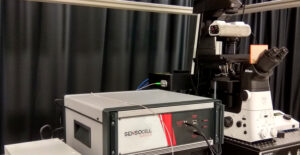Join us for the webinar: Light as a tool for mechanobiology-Introducing SENSOCELL optical tweezers
📅DATE: March 24, 2021 | 4 PM CET | ONLINE
If you are interested in new cutting edge mechanobiology technology can’t miss the webinar series organized by Massimo Vassalli from the Cellular Mechanobiology Lab at the University of Glasgow and N4M:Nanoengineering for Mechanobiology.
Join us online for the exciting talk:
Light as a tool for mechanobiology : Introducing SENSOCELL optical tweezers
IMPETUX will participate introducing SENSOCELL optical tweezers and Dr. Krieg from the Neurophotonics and Mechanical Systems Biology Research Group at ICFO will show the photonic solutions applications to the field of Mechanobiology.
During my talk, I will highlight recent progress to understand the interplay between cellular and molecular nanomechanics and their role in regulating cellular physiology. I focus on work on the nervous system of the roundworm Caenorhabditis elegans, which is a popular experimental system to combine engineering, biophysics and cell biology, due to its stereotyped body plan, known structural connectome and amenable genetics. C elegans uses a set of different sensory neurons to navigate its habitat which endow the animals to process chemical and mechanical stimuli in a changing environment. Some of these neurons respond to minute mechanical forces delivered to the skin of the animal, while others respond to stresses generated within the animals that originate from muscle contraction during locomotion. How these stresses are borne by molecular mechanics, transmitted within biological tissues and activate biochemical pathways is one of the last challenges in mechanosensory biology. This lack of understanding is largely due in part to the absence of appropriate techniques to investigate the effect of mechanical properties of cells and neurons within living organisms at the level of a single molecule. In this webinar, I will highlight some recent efforts from our lab to further our understanding of how mechanical stresses distribute within cells and enable mechanosensory behavior such as touch and proprioception.
Time remaining before the start of this event:
Day(s)
:
Hour(s)
:
Minute(s)
:
Second(s)





